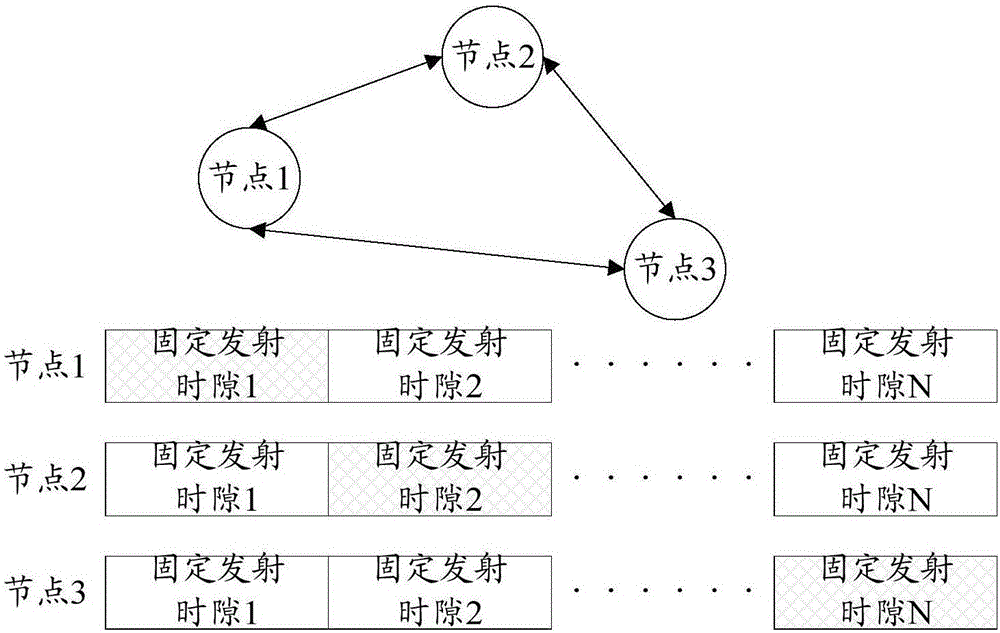Routing method of time division multiple access (TDMA) self-organizing network and device
A self-organizing network and time-division multiple access technology, which is applied in the field of network management, can solve problems such as not involving self-organizing network, only a single route design, and no corresponding optimization
- Summary
- Abstract
- Description
- Claims
- Application Information
AI Technical Summary
Problems solved by technology
Method used
Image
Examples
no. 1 example
[0106] refer to Figure 8 , Figure 8 It is a schematic flowchart of the second embodiment of the routing method of the time division multiple access ad hoc network of the present invention. Based on the first embodiment of the routing method of the above-mentioned time division multiple access ad hoc network, the method also includes:
[0107] Step S50, selecting the transmission path that meets the minimum communication requirements and has the least number of relay nodes from the link quality table;
[0108] Step S60, sending route establishment signaling according to the selected transmission path;
[0109] Step S70, each relay node on the transmission path applies for a relay time slot;
[0110] Step S80, when all relay nodes on the transmission path successfully apply for relay time slots, feed back routing request success information from the destination node according to the received routing establishment signaling;
[0111] Step S90, when at least one relay node o...
no. 2 example
[0117] refer to Figure 10 , Figure 10 It is a schematic flowchart of the third embodiment of the routing method of the time division multiple access ad hoc network of the present invention. Based on the second embodiment of the routing method of the above-mentioned time division multiple access ad hoc network, the method also includes:
[0118] Step S100, when the relay node and / or the destination node receive the data information sent from the source node, judge whether the node is the receiving node of the data information according to the physical layer framing of the data information;
[0119] Step S110, when the current node is not the receiving node of the data information, discarding the data information;
[0120] Step S120, when the current node is the receiving node of the data information, analyze the transmission path from the MAC layer framing of the data information;
[0121] Step S130, when the current node is a relay node in the transmission path, forward t...
no. 4 example
[0132] refer to Figure 14 , Figure 14 It is a schematic flow chart of the fifth embodiment of the routing method for the time division multiple access ad hoc network of the present invention. Based on the fourth embodiment of the routing method of the above-mentioned time division multiple access ad hoc network, the method also includes:
[0133] Step S180, when the link quality information of the transmission path changes, search for a new transmission path, and compare the new transmission path with the original transmission path;
[0134] Step S190, when the new transmission path occupies fewer relay nodes than the original transmission path, directly switch to the new transmission path to send the communication information;
[0135] Step S200, when the new transmission path occupies more relay nodes than the original transmission path, and the signal-to-noise ratio of the new transmission path is greater than the preset threshold value of the signal-to-noise ratio of t...
PUM
 Login to View More
Login to View More Abstract
Description
Claims
Application Information
 Login to View More
Login to View More - R&D
- Intellectual Property
- Life Sciences
- Materials
- Tech Scout
- Unparalleled Data Quality
- Higher Quality Content
- 60% Fewer Hallucinations
Browse by: Latest US Patents, China's latest patents, Technical Efficacy Thesaurus, Application Domain, Technology Topic, Popular Technical Reports.
© 2025 PatSnap. All rights reserved.Legal|Privacy policy|Modern Slavery Act Transparency Statement|Sitemap|About US| Contact US: help@patsnap.com



